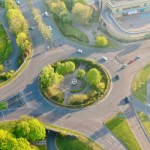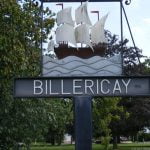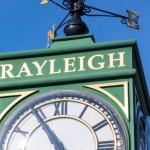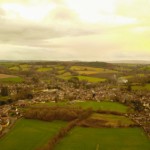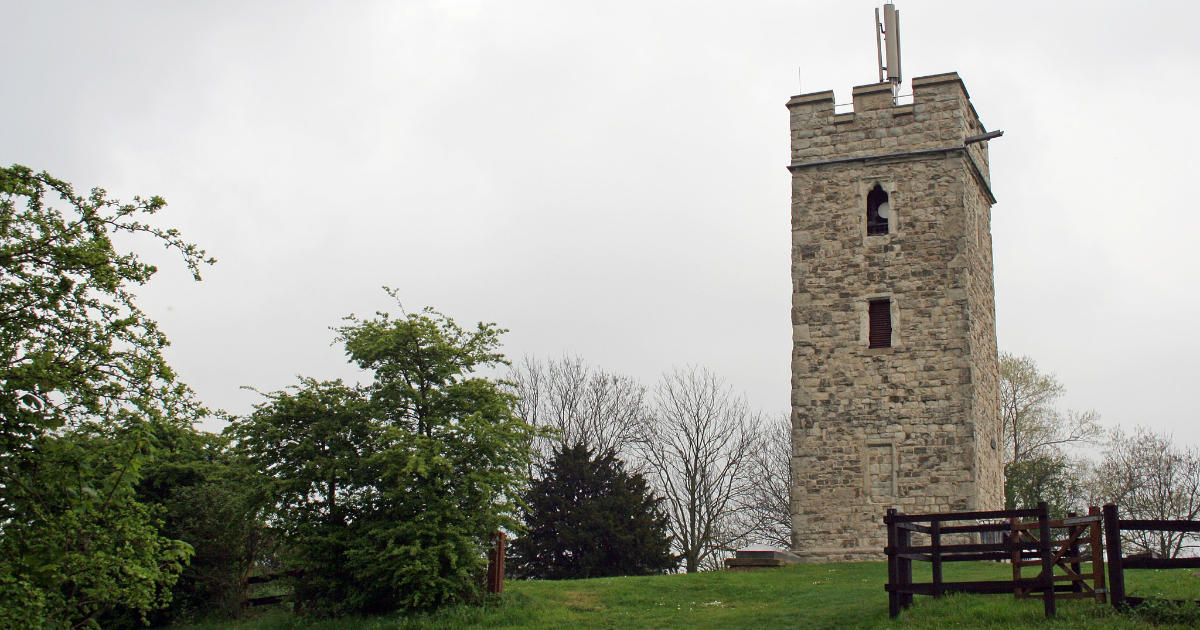
Outside of a few hardcore non-league football fans the town of Pitsea is probably not that well know outside of Essex. This is probably as it is often lumped in with Basildon, however, it is a destination in its own right.
After all, it has its own football teams, market, and railway station. Plus it’s home to over 25,000 inhabitants. It is also two miles away from Basildon which is a fair old walk. In fact further apart from its neighbour than many other larger towns and even cities.
We did a quick google on the place and it brought up some unfavourable comments, however, you should never believe everything you read on the internet. So given this, we decided to dig a bit deeper and decided it is worthy of its own impartial guide.
Still with us, great then without too much further ado here is our take on this somewhat maligned place. After all, everywhere has some redeeming features, don’t they?
Pitsea: A brief history
We like to start our virtual tours with a bit of history and although Pitsea was probably inhabited way back it most likely became a village of sorts in the 5th Century. This stems from the name which is probably of Saxon origin. After all, they did occupy most of southeast England around that time. However, there is not a whole lot known about these early years although it is likely that the surrounding area suffered from the Viking raids in the 9th Century given the River Crouch would have been navigatable by the Long Ships. There are records of the locals repelling a Viking raid in battle at Benfleet in 894 which supports this theory.
Roll on a couple of centuries and it belongs to William the Conqueror. In 1086 the Domesday Book records the town as Piceseia and geographically within the Barstable Hundred. It probably remained an agricultural village for the next few hundred years though.
Things didn’t stand still though and St Michaels Church was built in the 13th Century and Pitsea Hall was added to the locale in the 15th Century. Both are still standing, well in a fashion anyway where the church is concerned.
The Plague
The area was probably still mainly agricultural when the Black Death arrived in 1388. This hit the whole area hard and the population was slow to recover. The rise of sheep farming further hindered population growth as it was less labour intensive. Another blow to the locale came in 1642 when most of the Essex men joined Cromwell’s Ironsides during the Civil War. Although on the winning side, many never returned.
Pitsey Mill
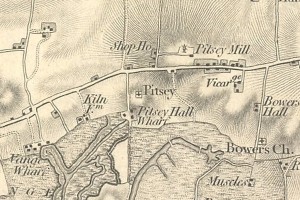
The above extract from an old 1805 map seems to indicate there was a mill here so it is probable that things were starting to industrialise a little. This of course moved more swiftly with the arrival of the railway in 1855.
The original railway station opened at Pitsea that year when the London to Southend extension was given government approval. This line, linking Pitsea with London via Tilbury, reached Southend in 1856 and would later be extended further to Shoeburyness by 1884. A new station was built in 1888 when a second ‘direct’ line linking Pitsea with Barking via Laindon and Upminster was completed.
Following the arrival of the railway, Pitsea began to develop and by the early 1900s, the High Road had grown with the addition of several shops and small businesses serving a rapidly expanding community. The town grew quite quickly during the first half of the 20th Century with swathes of land auctioned off for development and a number of quite impressive buildings were added.
Pitsea Market Opens
The locally famed Pitsea market opened in 1925 remaining on its original site until the late 1970s when it moved to the rear of the Railway public house adjacent to Rectory Park Drive. It was later resited again in 2014 to where the original Railway had stood during the second ‘Pitsea Regeneration’.
Part of the New Town
Post-war Britain needed room to grow and Government plans for the creation of several ‘new towns’ to alleviate London’s housing problems were approved in 1949. This led to Pitsea, along with Vange, Laindon, Langdon Hills and parts of Dunton and Nevendon being designated into a new town. It was eventually decided that it would be named Basildon, as although it was then only a relatively small village, was most central in the designated area.
The Pitsea Flyover
During the 1970s the Pitsea skyline was transformed when the controversial Pitsea flyover was completed in the early 1970s. Basildon Development Corporation plans for the realignment of the A13 had been a high priority since its inception and as the town developed the original route was unable to cope with the increase in traffic. Original plans show the proposed new route crossing the Pitsea/Tilbury railway, passing over Vange marsh, continuing through what would later become Wat Tyler Park, crossing back over the railway and thus avoiding Pitsea altogether.
These plans were never adopted and the road was realigned and duelled from the Five Bells roundabout to join with its original course just beyond Rectory Road. Station Lane, which linked the High Road with the railway station, was truncated as part of the development and in the 1980s the A13 was realigned again as a continual dual carriageway to the Sadlers Farm roundabout. The former route between London Road, Vange through Pitsea and Bowers Gifford to Sadlers Farm is now the B1464.
Two of the towns oldest buildings are in Pitsea. Cromwell Manor in Pitsea Hall Lane dates from the 15th century and was once known as Pitsea Hall, and Great Chalvedon Hall in Tyefields, which was built sometime in the 16th century. St. Michael’s church was built much earlier but the present remains (the tower) date from 1870 when the church was last rebuilt.
Pitsea Redevelopment
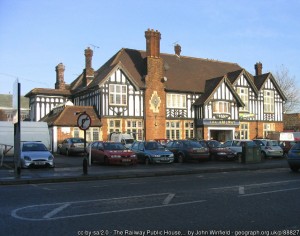
In 2013 the planned regeneration of the Pitsea market site and adjacent land got underway with the demolition of the former Railway Hotel public house which had stood empty since 2006. Pitsea swimming pool was also demolished along with the former Sainsbury’s supermarket building which had been occupied by budget supermarket chain Aldi, who relocated in 2014 to a new building located on part of the third Pitsea market site.
The regeneration’s main development, a proposed supermarket to be occupied by Morrisons, was completed in early 2016 though the company announced they would not be moving in; instead the home and garden chain The Range let a sizeable floor area, opening in July 2016.
So now we are up to date let’s have a look at what’s worth visiting.
Buildings of Note
It would be fair to say that there is not a whole lot to attract the Architect aficionado, however, the following are worth a look.
St. Michael’s Tower is sadly all that remains of the 13th-century church of St. Michael. It was once a thriving church but following its deconsecration in 1983, it became a vandals paradise and in 1998 all but the tower was demolished. Sad but at least it is still there on the Pitsea Mount looking down over the town. It also hosts a mobile mast so you can thank the original builders for your signal.
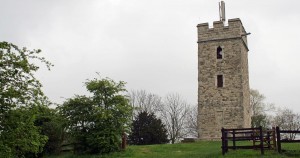
Image: oneblackline/CC BY-SA 3.0
Great Chalvedon Hall in Tyefields, which was built sometime in the 16th century has quite a history to it. Quirks include it having its own Priests hole (a secret room where Catholic priests could hide from the wrath of Queen Elizabeth I) and a now sadly collapsed escape tunnel. Even better it is now a pub so you can indulge a little while taking in the culture Who said history had to be boring!
Cromwell Manor is also worth a visit, being a grade II listed building. It is set on its own grounds. and dates from the 15th Century. It is a popular local wedding venue and also a nice place to stay for those choosing Pitsea as their base to explore the rolling Essex countryside.
Given most of the rest of the town was built in the last 50 years that’s about it, but hey we never said it was an architectural treasure trove.
Things to Do in Pitsea
So you find yourself in Pitsea now what? Well, why not check these things out.
Visit the Market
Fancy a bit of budget retail therapy? You are in luck as Pitsea has a great market! It’s so good that it even has its own Facebook page called.. you guessed it “The GREAT Pitsea market“. It is in full swing on Wednesdays, & Friday – Sunday, with Friday being Vintage day. It’s easy to find just follow the noise.
Sport
Pitsea is the home of semi-professional football club Bowers & Pitsea FC and Hashtag United. They both play at Crown Avenue, known formally as the Len Salmon Stadium. Bowers & Pitsea also have many youth teams playing in the local area. Check out our Bowers & Pitsea FC team guide for contact details and a bit of the club’s history.
If you like cricket then the Basildon & Pitsea Cricket Club is pretty close and their 1st XL play on a Saturday. They have won a bit of silverware over the years so you should get to see a good game.
Go Fishing or Walking
Northlands Park is the place for this. It has a couple of big well-stocked lakes for the coarse angler, with large Carp, Bream & Pike being the main species on offer. There are also smaller numbers of Roach & Rudd and also a few Perch & Tench for the more patient fisherman. The River Crouch is also within easy reach and you can catch Trout, Roach & Bream there. It even has its own conservation trust.
For those less keen to wet a line there are plenty of nice walks and of course a cafe for that all-important post-walk cuppa.
Head for the Beach
Bell Wharf Beach at Leigh on Sea, is just over 7 miles away and there is a train service you can use. Again if fishing is your thing there is plenty of shore fishing opportunities.
Grab a Drink or Some Lunch
We have already mentioned the two most historic watering holes above, and either would make a great place to stop off at. However, if you7 want something a little less ostentatious then try The Gun Pub, on London Road to any one of a number of cafes and restaurants that are available.
How to get here
We’ve almost brought you up to speed on this interesting town. All that’s left is to show you the way to go.
By Road
Head for the A13 and enjoy a trip over the Pitsea Flyover.
By Rail
Pitsea railway station is on the London, Tilbury and Southend line. The easiest way would be to head for Fenchurch Station in London.
By Air
London Southend Airport is only about 11 miles away and there are regular train services to and from it.
By Boat
You are in luck if you have a smallish boat as the Wat Tyler Country Park Marina is located at the end of Pitsea Creek. This is on the northern shore of the Thames estuary and thus navigatable. Check out the local council website for more details.
So there you have it the Five Minute Spare Pitsea guide. See you shouldn’t believe the bad press, this is a great staycation base which may be lacking a bit in history, but it has Football a beach nearby good transport links and a nice park. Add to this the surrounding countryside and the fact that you can even sail your yacht there mote than makes up for the odd unfriendly local and that flyover. So what are you waiting for go check out our Basildon directory which is full of places to stay and enjoy a staycation with a difference.
